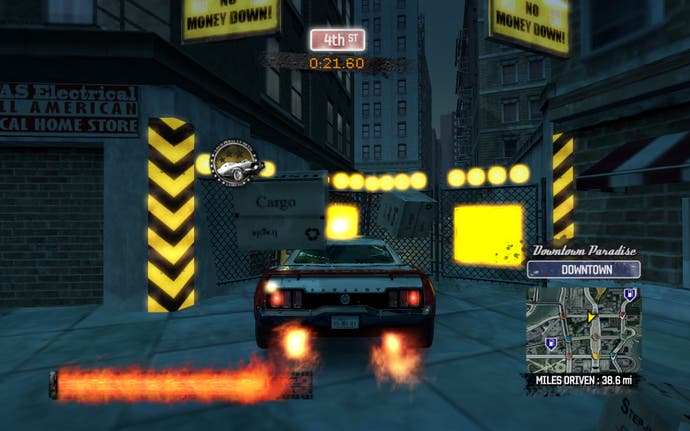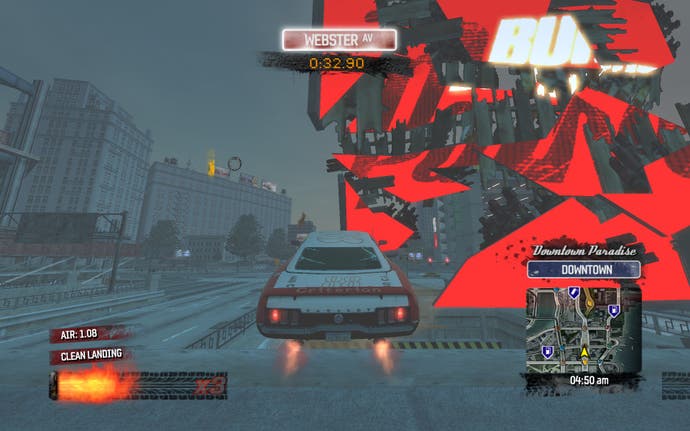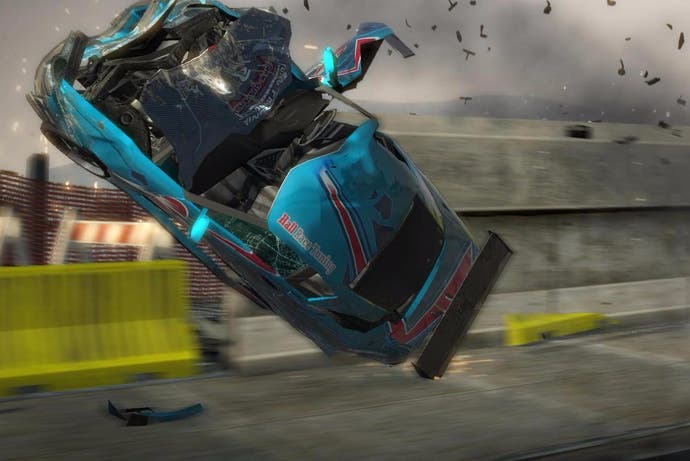Burnout Paradise is gaming perfection
Axel roads.
Editor's note: As Burnout Paradise finally arrives on the backwards compatibility list for Xbox One, we thought it was time to revisit this astonishing game.
This was meant to be a piece on Battlefield 1. Then it was meant to be a piece on Titanfall 2. Then someone asked if I might fancy writing a little something about Mass Effect. No. I might not fancy that. I might not fancy any of that. Instead I will do what I have been doing instead of all those other things I should have done. I have been circling and circling in Paradise City, picking up speed and picking up speed until the whole place becomes a particle accelerator that I flow through, rush through, course through, travelling faster and faster, burnout piling upon burnout until time and space have been so roughly treated by proceedings that they break down completely and I collide with myself coming back the other way and then watch as the world fragments in a blinding pulse of white light. This will happen. I am certain of it. It's the Burnout Paradise end-game that I have always suspected is out there somewhere, lurking deep in the code just ten, twenty, thirty mph beyond my reach.
Burnout Paradise is a game that I feel bad for liking as much as I do, almost as if it were a chinchilla hair coat that, annoyingly, goes just perfectly with my favourite trousers. Many games come with a human cost, of course - the long hours of development, the neglected families, the unfortunate tantrums and the jumping up and down on other people's desks. But with a game as brilliantly machine-tooled as Paradise, that cost is suddenly unavoidably obvious. The way the arcing curves of its freeways meet up, ideal transitions you will rarely even notice as sheer speed spins you from one arm of the city to the next? These are elements that, in their near-perfect invisibility, nonetheless make themselves felt just enough to nod you towards the pain and suffering that must have been required in order to locate them and implement them. You feel the seams shifting in the concrete and are given pause. Someone must have seriously busted out the protractor and engineer's quadrille on this one.

Or, to put it another way, while I'll readily admit that I still understand very little about the practical business of making games, I realise afresh that I have absolutely no idea whatsoever how something like Burnout Paradise was put together. But I bet it hurt.
And it should have hurt. Because Burnout was already perfect. Burnout 3 was perfect, anyway: a game about driving badly, but driving badly well. A game in which driving badly sufficiently well - or driving well sufficiently badly - rewarded you with boost that allowed you to drive even more badly, even more well, at massively increased speeds. And when you crashed in Burnout 3, it wasn't the end of the fun. It was the start of the fun, as time slowed to become a thick gel through which sparks and shrapnel moved with a villainous apocalyptic sluggishness as you steered your wreckage - steered it! - towards the oncoming headlights of your innocent rivals. Testify! A stolen moment in which you could turn defeat into a bitter kind of rolling victory. A game which absolutely refused to pluck control from the player if there was still some fun to be had with it.
How to top that? With Revenge, of course, which built on perfection by doubling down on chaos. Burnout 3 offered a glimpse of this promise, I think. It offered a glimpse of the game that Burnout seemed to be headed towards becoming, and the glimpse was visible at a lazy corner of the road, say, taken at speed, late-on in a race, where a collision somewhere behind you might fling traffic hurtling through the air over your head, and you might suddenly realise that your particular hectic metal deadliness was only one part of a vast machine of screaming, accident-prone fender-bending potential. Revenge's means of getting at more of that stuff? It introduced traffic checking, in which any vehicles going in the same direction as you were suddenly fair game. Fair game! You could ram into them and they wouldn't hurt you. Rather, they would just bounce cheerily down the tarmac in front of you, taking out any unfortunates who might have had the gall, the temerity, to beat you into second place. (I realise at this point that I don't actually know what temerity means, but I refuse to look it up.)

Where to go from there? Katamari Damacy seemed the only option, right? Burnout's future trajectory was surely going to be about the cars themselves, clumping together to form larger and larger bait balls of chaos as they crunched around, eating up the oncoming traffic. I can see that game happening. I can imagine what it would be like to play, what it would look like. Cars battered and warped and softened until they look like metallic choux buns. Cars welded together by impacts, rolling down the street together like a new kind of animal. Amazing stuff, but it's not Paradise. Paradise did something equally audacious, but it went the other way.
Rather than zero in on the car, forever hurtling around a corner, forever poised between control and chaos, forever edging into the wrong lane where beautiful catastrophe awaits, Paradise pulled back to examine the world outside the car, the world rushing by regardless. What if that world was all connected? What if all the roads had permanent locations within the same space, and could be navigated as you saw fit? What - and this is blasphemy - what if you got rid of those glowing chevrons which fenced the courses off so that you didn't really have to worry too much about where you were going in the first place? These chevrons, I always think of them as the gutter guards they put up at bowling alleys when little kids are learning to play. They seemed like an essential part of what Burnout was: streamlined, pared down, relentless. Then, Paradise took them away. Suddenly, all of the races you were entered into were taking place in a wider somewhere. Suddenly, you couldn't just focus on the rival you were planning on barging into the spars of a concrete underpass, but you also had to leave a little bit of attention free for where the finish line was and which cross streets you were going to need to use to get there.
So Paradise is a Burnout game that wants to split your attention? In truth, that's not at all how it really feels when you're playing. The greatest change to the overall design forced by the fact that races and other events are now scrambled across the surface of a fixed and rigid city layout is probably the new primacy of the e-brake, which allows you to make precision right-angle turns from one road to another at a nano-second's notice. God, I love the e-brake. It's so Burnout, I had to call my dad and ask him if e-brakes were a real thing or if Criterion had just invented them for this game. They invented this handling of them, anyway: this sense that you are rushing through some kind of busy artery, bubbling along with all the other bustling cells, and then you choose to insert yourself into a different bloodstream with boldness and flare, cutting across all that intimate traffic. It's amazing to think: by the time Criterion had moved onto Hot Pursuit - which is also a masterpiece, obviously - people were starting to worry about the corners in its games. Or rather, they were starting to worry about the lack of them. Some of Hot Pursuit's best tracks were pretty much straight lines, with the occasional reluctant curve in the middle. It was all about the headlong pelt. Well, Paradise is built of turns, of turns that come in a variety of forms, from those sharp, microsurgical right-angles where you deploy the e-brake just so, to the other kind, the broad, generous curves that I've come to realise are the real reason the whole thing works as well as it does in the first place.

Those freakin curves. Oh boy. This is why Paradise seems such an alien kind of achievement, such an improbable piece of spatial thinking. It's a wide, rangy city with many different sites, and yet every road takes you, eventually, to every other road. It may not look like it on the map screen, but the whole thing feels like a series of nested and interlocking circles: pick a direction and you will never run out of track. Not ever. You will simply loop back around, sooner or later, until you are on fresh track, where the whole thing repeats. Imagine flinging a ball bearing into the bright, glittering spaces of a pinball machine, safe in the knowledge that you will never have to touch the flippers, safe in the knowledge that the ball bearing is never going to stop moving. And then replace the ball bearing with a Burnout car, which is to say a menacing entity that, channeled through the pad and the arms, seems to be all nose, supported by tyres so weighty and toothed that they appear to chew their way across the road, screaming high speeds but nonetheless connected. Not bad, Criterion. Not bad at all.
Speed and the curving road and the things that your instincts can handle by themselves when you are paying little attention to them: this is not a game to be intellectualised. Burnout Paradise is, in fact, the antithesis to thinking. I mean this as a supreme compliment: if you are thinking when you're playing Burnout Paradise, you are not playing Burnout Paradise. Its state is one of wordless action, absolute act, regardless of whether you have decided to play Marked Man, Road Rage, Stunt Run or a simple race. Online or offline. Its state is one of blasting around for hours on end, clocking up the miles and trading paint before realising, all of a sudden, that you have neglected to enter any events at all, that you have merely been speeding, crashing, surviving, and thriving. Merely.
This is the way to play the game, organised content cast aside, plans neglected, pets unfed while your fingers grip the control pad and Avril Lavigne sings Girlfriend, one of the most aggressively wretched songs of all time, and needless to say, the only song on the soundtrack that is exactly right for what you are doing - slamming through Agility-Orb-alike yellow gate after yellow gate in improbable chains, keeping yourself moving through sheer mindless will, racing through the day, the night, the endless looping cycle of skies.

And who's driving? Nobody in the cars: that's Burnout lore by this point, the empty seats providing a frisson of post-human sci-fi alongside those guilt-free collisions. And certainly not you. You're not driving. Ideally, you are just a spectator in your own head by this point, watching your hands on the controls doing improbably things, watching the light change and the traffic lights change, dimly aware of the world rushing past. No. If Burnout Paradise had the crazy ambition to take video games' most grippy, aggressively straight-ahead handling system and shove it into an open world, the true mark of the development team's success is that, ultimately, it's the city itself that's driving: an endless expanse of beautifully deployed real estate, all of which is urging you on, towards a horizon that will never, ever get any closer.

